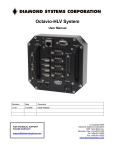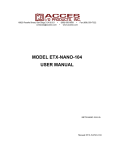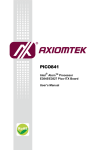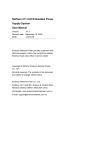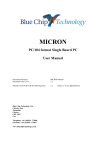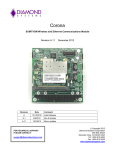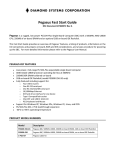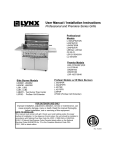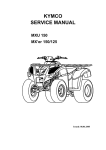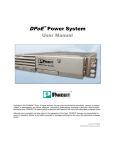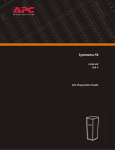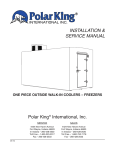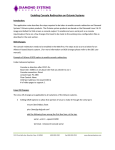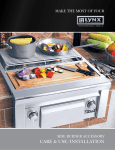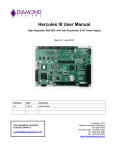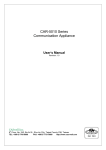Download Helios Panel I/O Board User Manual
Transcript
HELIOS PANEL I/O BOARD User Manual Revision A.01 March 2015 Revision Date Comment A.00 5/9/11 Initial Release A.01 3/3/15 Minor update to Power section FOR TECHNICAL SUPPORT PLEASE CONTACT: [email protected] Copyright 2015 Diamond Systems Corporation 555 Ellis Street Mountain View, CA 94043 USA Tel 1-650-810-2500 Fax 1-650-810-2525 www.diamondsystems.com CONTENTS Important Safe-Handling Information .....................................................................................................................3 1. Description ........................................................................................................................................................4 2. Block Diagram ...................................................................................................................................................4 3. Mechanical Drawing .........................................................................................................................................5 4. Functional Description .....................................................................................................................................6 4.1 SBC I/O Section.............................................................................................................................................6 4.2 Expansion I/O Section ...................................................................................................................................6 4.3 Power Section................................................................................................................................................6 5. SBC I/O Section – Bottom Side .......................................................................................................................7 5.1 Ethernet .........................................................................................................................................................7 5.2 Input Power....................................................................................................................................................7 5.3 PS/2 Keyboard / Mouse .................................................................................................................................7 5.4 VGA Connector..............................................................................................................................................7 5.5 Serial Ports ....................................................................................................................................................8 5.6 USB 0/1 and USB 2/3 Connectors ................................................................................................................8 5.7 Digital I/O .......................................................................................................................................................8 5.8 Data Acquisition I/O Connector .....................................................................................................................9 5.9 Miscellaneous Signals ...................................................................................................................................9 6. SBC I/O Section – Top Side .......................................................................................................................... 10 6.1 Input Power................................................................................................................................................. 10 6.2 Ethernet ...................................................................................................................................................... 10 6.3 VGA ............................................................................................................................................................ 10 6.4 USB ............................................................................................................................................................ 10 6.5 PS/2 Keyboard and Mouse ......................................................................................................................... 10 6.6 Data Acquisition .......................................................................................................................................... 10 6.7 Serial Ports ................................................................................................................................................. 11 6.8 Digital I/O .................................................................................................................................................... 11 6.9 Expansion I/O Connector (External) ........................................................................................................... 11 7. Expansion I/O Section ................................................................................................................................... 12 7.1 Serial Port Expansion ................................................................................................................................. 12 7.2 General Purpose Expansion ....................................................................................................................... 12 8. Power Section ................................................................................................................................................ 13 Helios Panel I/O Board User Manual Rev A.01 www.diamondsystems.com Page 2 IMPORTANT SAFE-HANDLING INFORMATION WARNING: ESD-Sensitive Electronic Equipment! Observe ESD-safe handling procedures when working with this product. Always use this product in a properly grounded work area and wear appropriate ESD-preventive clothing and/or accessories. Always store this product in ESD-protective packaging when not in use. Safe Handling Precautions Aurora contains numerous I/O connectors that connect to sensitive electronic components. This creates many opportunities for accidental damage during handling, installation and connection to other equipment. The list here describes common causes of failure found on boards returned to Diamond Systems for repair. This information is provided as a source of advice to help you prevent damaging your Diamond (or any vendor’s) embedded computer boards. ESD damage – This type of damage is almost impossible to detect, because there is no visual sign of failure or damage. The symptom is that the board simply stops working, because some component becomes defective. Usually the failure can be identified and the chip can be replaced. To prevent ESD damage, always follow proper ESD-prevention practices when handling computer boards. Damage during handling or storage – On some boards we have noticed physical damage from mishandling. A common observation is that a screwdriver slipped while installing the board, causing a gouge in the PCB surface and cutting signal traces or damaging components. Another common observation is damaged board corners, indicating the board was dropped. This may or may not cause damage to the circuitry, depending on what is near the corner. Most of our boards are designed with at least 25 mils clearance between the board edge and any component pad, and ground / power planes are at least 20 mils from the edge to avoid possible shorting from this type of damage. However these design rules are not sufficient to prevent damage in all situations. A third cause of failure is when a metal screwdriver tip slips, or a screw drops onto the board while it is powered on, causing a short between a power pin and a signal pin on a component. This can cause overvoltage / power supply problems described below. To avoid this type of failure, only perform assembly operations when the system is powered off. Sometimes boards are stored in racks with slots that grip the edge of the board. This is a common practice for board manufacturers. However our boards are generally very dense, and if the board has components very close to the board edge, they can be damaged or even knocked off the board when the board tilts back in the rack. Diamond recommends that all our boards be stored only in individual ESD-safe packaging. If multiple boards are stored together, they should be contained in bins with dividers between boards. Do not pile boards on top of each other or cram too many boards into a small location. This can cause damage to connector pins or fragile components. Power supply wired backwards – Our power supplies and boards are not designed to withstand a reverse power supply connection. This will destroy each IC that is connected to the power supply. In this case the board will most likely will be unrepairable and must be replaced. A chip destroyed by reverse power or by excessive power will often have a visible hole on the top or show some deformation on the top surface due to vaporization inside the package. Check twice before applying power! Bent connector pins – This type of problem is often only a cosmetic issue and is easily fixed by bending the pins back to their proper shape one at a time with needle-nose pliers. This situation can occur when pulling a ribbon cable off of a pin header. Note: If the pins are bent too severely, bending them back can cause them to weaken unacceptably or even break, and the connector must be replaced. Helios Panel I/O Board User Manual Rev A.01 www.diamondsystems.com Page 3 1. DESCRIPTION The Helios panel I/O board plugs directly onto the Helios PC/104 single board computer and provides industrytype I/O connectors for all I/O features on the board. The panel I/O board mounts in the Pandora enclosure to provide a cable-free mounting system for Helios. Key feature highlights include: Plugs onto the Helios SBC and provides all I/O without cables Provides additional front panel I/O for 2 additional PC/104 boards Mounts in Pandora enclosure Provides connection for power switch Provides power paths for +5V and variable voltage input 2. BLOCK DIAGRAM 50-Pin Connector 50-Pin Connector Expansion I/O Section 20-Pin Connector DB9M (2) Helios CPU 10/100 Ethernet RJ-45 COM1 - COM4 DB9M (4) VGA DD15F PS/2 Keyboard/Mouse MiniDIN6 (2) CPU I/O Section USB0 - USB3 USB-A (4) Miscellaneous Speaker, Reset Switch 16 Digital I/O + SPI DB25F Data Acquisition PC/104 Bus 50-Pin Connector +5V in Items in blue are not part of panel board +5V in Input Power Connector Power Supply Connectors DC/DC Power Supply (separate device) Vin Connections for front panel switch +5V Out Helios Panel I/O Board User Manual Rev A.01 Power Section www.diamondsystems.com Page 4 3. MECHANICAL DRAWING A mechanical drawing of the Helios panel I/O board connector layout is provided below. The drawing shows the top side of the panel I/O board with the relative connector locations. All I/O connectors are located on the board so that there is sufficient room to install all connectors without interference with any other connector or mounting hole. Helios Panel I/O Board Top Side Helios Panel I/O Board User Manual Rev A.01 www.diamondsystems.com Page 5 4. FUNCTIONAL DESCRIPTION The panel I/O board contains three major sections: SBC I/O section, Expansion I/O section, and Power section. 4.1 SBC I/O Section The SBC I/O section brings out all the SBC I/O to the front panel connectors. The top side of the panel I/O board has industry standard I/O connectors, and the bottom side provides dual row 2mm pin sockets to mate with the corresponding 2mm pin headers on the Helios SBC. 4.2 Expansion I/O Section The Expansion I/O section contains additional connectors for bringing out the I/O from PC/104 modules installed below the Helios SBC within the enclosure. The first expansion connector provides I/O for a generic PC/104 I/O board. It includes a 50-pin 2x25 .1” pitch pin header for mating with a standard ribbon cable that connects to the I/O connector of a PC/104 board. This pin header is on the bottom right side of the panel I/O board in a spot convenient for mating with the standard PC/104 board I/O connector location. On the top side a latching 50 pin connector is provided for external access to this I/O. The second expansion connector provides I/O for a Diamond Emerald EMM-XT or EMM-4M-XT serial port board. It provides a 2x10 .1” pitch pin header on the bottom left side for connection to the EMM board, and 2 DB9M connectors on the top side for external access. 4.3 Power Section The Power section provides two paths for input power coming from either a 5VDC source or a variable input voltage source. The 5V source is routed through a 1x2 .1” pitch friction lock connector to a front panel switch, and then to a pin socket on the bottom side that mates with the Helios SBC. The switch connector can be bypassed with a jumper if desired. The variable input voltage source is routed through another 1x2 .1” pitch friction lock connector to a front panel switch and then to a separate 1x2 .1” pitch friction lock connector for connection to a DC/DC power supply mounted inside the enclosure. The 5VDC output of this DC/DC power supply then has two paths to the Helios SBC: (1) It can connect directly to the PC/104 bus of the system, if the power supply is mounted on the bus; or (2) It can be routed back to the panel I/O board with another connector and then to the Helios SBC through the panel I/O board’s pin socket connection. The panel I/O board also provides a path for optional +12VDC output from the power supply to the Helios SBC through the pin socket. The power section contains a green LED which is connected to the +5VDC signal to indicate power status. Helios Panel I/O Board User Manual Rev A.01 www.diamondsystems.com Page 6 5. SBC I/O SECTION – BOTTOM SIDE All these connectors are on the bottom side of the panel I/O board. Their locations and pinouts match exactly the corresponding connectors on the Helios SBC. The pin numbering of these connectors, when facing the connector, is reversed from the pin numbering on the male pin headers. 5.1 Ethernet TX+ NC RX+ Link LED Key 5.2 1 3 5 7 9 2 4 6 8 10 TXRXNC Ground Duplex 1 3 5 7 2 4 6 8 +5V Ground Ground +12V Input Power +5V +5V Ground +12V The power signals on this connector come from either the front panel input power connector or from a connector leading to the output from a DC/DC power supply installed in the system. 5.3 PS/2 Keyboard / Mouse This connector provides the standard PS/2 keyboard and mouse signals. For a standard configuration, a 2x4 connector may be installed in positions 1-8 for compatibility with the existing DSC cable. For a latching configuration, the 2x5 connector is installed. +5V KB Data KB Clk Ground NC 5.4 1 3 5 7 9 2 4 6 8 10 NC MS Data MS Clk NC NC VGA Connector This connector provides a connection for VGA monitors. Note that while the DDC serial detection pins are present, there is no 5V supply provided, nor are the old “Monitor ID” pins used. RED GREEN BLUE HSYNC VSYNC 1 3 5 7 9 2 4 6 8 10 Helios Panel I/O Board User Manual Rev A.01 Ground NC Ground DDC-Data DDC-Clock www.diamondsystems.com Page 7 5.5 Serial Ports This connector provides access to the four serial ports from the Vortex CPU chip. Ports 1 and 2 may be jumperconfigured for RS-232, RS-422, or RS-485 protocols, while ports 3 and 4 are fixed RS-232 only. RS-232 Configuration Port 1 Port 2 Port 3 Port 4 5.6 DCD 1 RXD 1 TXD 1 DTR 1 GND DCD 2 RXD 2 TXD 2 DTR 2 GND DCD 3 RXD 3 TXD 3 DTR 3 GND DCD 4 RXD 4 TXD 4 DTR 4 GND 1 3 5 7 9 11 13 15 17 19 21 23 25 27 29 31 33 35 37 39 2 4 6 8 10 12 14 16 18 20 22 24 26 28 30 32 34 36 38 40 RS-422 Configuration DSR 1 RTS 1 CTS 1 RI 1 NC DSR 2 RTS 2 CTS 2 RI 2 NC DSR 3 RTS 3 CTS 3 RI 3 NC DSR 4 RTS 4 CTS 4 RI 4 NC NC TXD+ 1 GND RXD+ 1 GND NC TXD+ 2 GND RXD+ 2 GND 1 3 5 7 9 11 13 15 17 19 21 23 25 27 29 31 33 35 37 39 2 4 6 8 10 12 14 16 18 20 22 24 26 28 30 32 34 36 38 40 NC TXD- 1 RXD- 1 NC NC NC TXD- 2 RXD- 2 NC NC RS-485 configuration NC TXD/RXD+ 1 GND NC GND NC TXD/RXD+ 2 GND NC GND 1 3 5 7 9 11 13 15 17 19 21 23 25 27 29 31 33 35 37 39 2 4 6 8 10 12 14 16 18 20 22 24 26 28 30 32 34 36 38 40 NC TXD/RXD- 1 NC NC NC NC TXD/RXD- 2 NC NC NC USB 0/1 and USB 2/3 Connectors These connectors provide access to the 4 USB 2.0 ports. The shield pin is tied to system ground. The Key positions are missing to match the key position in the cable to prevent misconnection. NC USB1 PwrUSB1 Data+ USB1 DataUSB1 Pwr+ NC USB3 PwrUSB3 Data+ USB3 DataUSB3 Pwr+ 5.7 1 3 5 7 9 2 4 6 8 10 Shield / Ground USB0 PwrUSB0 Data+ USB0 DataUSB0 Pwr+ 1 3 5 7 9 2 4 6 8 10 Shield / Ground USB2 PwrUSB2 Data+ USB2 DataUSB2 Pwr+ Digital I/O This connector provides 16 digital I/O signals from the Helios SBC. It connects to a DB25F connector on the front panel. It is a 2x10 .1” pitch female pin socket connector. DIO LCA0 DIO LCA2 DIO LCA4 DIO LCA6 DIO LCB0 DIO LCB2 DIO LCB4 DIO LCB6 +5V NC 1 3 5 7 9 11 13 15 17 19 Helios Panel I/O Board User Manual Rev A.01 2 4 6 8 10 12 14 16 18 20 DIO LCA1 DIO LCA3 DIO LCA5 DIO LCA7 DIO LCB1 DIO LCB3 DIO LCB5 DIO LCB7 GND GND www.diamondsystems.com Page 8 5.8 Data Acquisition I/O Connector This connector provides data acquisition signals from the Helios SBC board, if the model supports data acquisition. It connects to a 50-pin male pin header on the front panel. It is a 2x25 .1” pitch female pin socket connector. DIO A0 DIO A2 DIO A4 DIO A6 DIO B0 DIO B2 DIO B4 DIO B6 DIO C0 DIO C2 DIO C4 / Gate 0 DIO C6 / Clk 1 Ext Trig +5V Out Vout 0 Vout 2 Aground (Vout) Vin 0 Vin 1 Vin 2 Vin 3 Vin 4 Vin 5 Vin 6 Vin 7 5.9 1 3 5 7 9 11 13 15 17 19 21 23 25 27 29 31 33 35 37 39 41 43 45 47 49 2 4 6 8 10 12 14 16 18 20 22 24 26 28 30 32 34 36 38 40 42 44 46 48 50 DIO A1 DIO A3 DIO A5 DIO A7 DIO B1 DIO B3 DIO B5 DIO B7 DIO C1 DIO C3 DIO C5 / Gate 1 DIO C7 / Out 0 Tout 1 Dground Vout 1 Vout 3 Aground (Vin) Vin 8 Vin 9 Vin 10 Vin 11 Vin 12 Vin 13 Vin 14 Vin 15 Miscellaneous Signals This connector provides access to common auxiliary signals used in a PC application. Ground IDE LED NC Reserved Speaker 1 3 5 7 9 2 4 6 8 10 Reset+5V Power LED LCD Backlight Ctrl +5V The signals on this connector that are used on the panel I/O board are described below: Speaker Out The signal on this pin is referenced to +5V Out. A small buzzer is connected between this pin and +5V Out. Power LED Referenced to +5V Out. Does not require a series resistor. An LED visible on the outside front panel is connected directly between this pin and +5V Out. Reset- Connection between this pin and Ground will generate a Reset condition. A momentary switch is connected between this pin and ground. Helios Panel I/O Board User Manual Rev A.01 www.diamondsystems.com Page 9 6. SBC I/O SECTION – TOP SIDE These SBC I/O connectors are on the top side of the panel I/O board. They face out through the enclosure front panel. 6.1 Input Power The input power connector is Molex part number 39-30-2045. Each pin has a 6A or greater current carrying capacity. Input power may be supplied either as +5VDC or as Vin. The +5V is intended to be switched directly to the PC/104 bus power pins via the external power switch. The Vin is intended to be switched to an auxiliary connector on the back side of the board which is used to connect to a DC/DC power supply. The output of the DC/DC power supply is then fed either to the PC/104 bus power pins (if the power supply is on the PC/104 bus) or back to the panel I/O board, and then to the Helios SBC through the +5V pins on the SBC mating power input connector. 1 2 3 4 6.2 Vin Ground Ground +5V In Ethernet The Ethernet connector is a vertical metal-shielded RJ-45 jack with industry standard pinout for 10/100Mbps Ethernet. The connector includes the LEDs for link and speed. The signals come from the Helios SBC mating Ethernet connector. Proper isolation must be maintained on all Ethernet signal routing to meet industry standard signal isolation specifications. No ground or power plane should be above or underneath these signals. The connector contains two LEDs connected to the Link and 100Mbps signals on the Ethernet SBC mating connector. 6.3 VGA The VGA connector is standard vertical DD15 female connector with industry standard VGA pinout. It has 4-40 thread inserts and hex screwlocks. The signals come from the Helios SBC mating VGA connector. 6.4 USB The USB connectors are 4 vertical metal shrouded type A connectors with industry standard pinout for USB. The signals come from the two Helios SBC mating USB connectors. 6.5 PS/2 Keyboard and Mouse The PS/2 connectors are 2 vertical Mini-DIN-6 connectors with industry standard pinout for PS/2 keyboard and mouse. The signals come from the Helios SBC mating PS/2 connector. 6.6 Data Acquisition The data acquisition connector is a vertical 50-pin connector with long ejector/latches for a mating ribbon cable connector with strain relief. The signals come from the Helios SBC mating data acquisition connector and have a 1 to 1 correspondence with that connector pinout. Helios Panel I/O Board User Manual Rev A.01 www.diamondsystems.com Page 10 6.7 Serial Ports The serial port connectors are 6 vertical DB9 male connectors. They have 4-40 thread inserts and hex screwlocks. Ports 1-4 signals come from the 40-pin SBC serial port connector and use the pinout shown below. Ports 5-6 signals come from the 20-pin expansion connector, and their pinout is given in section 7.1. Panel Connector COM1 COM2 COM3 COM4 6.8 Panel Pin 1 2 3 4 5 1 2 3 4 5 1 2 3 4 5 1 2 3 4 5 Signal Name DCD 1 RXD 1 TXD 1 DTR 1 GND DCD 2 RXD 2 TXD 2 DTR 2 GND DCD 3 RXD 3 TXD 3 DTR 3 GND DCD 4 RXD 4 TXD 4 DTR 4 GND Serial Port Connector 1 2 3 4 5 6 7 8 9 10 11 12 13 14 15 16 17 18 19 20 11 12 13 14 15 16 17 18 19 20 11 12 13 14 15 16 17 18 19 20 Signal Name DSR 1 RTS 1 CTS 1 RI 1 NC DSR 2 RTS 2 CTS 2 RI 2 NC DSR 3 RTS 3 CTS 3 RI 3 NC DSR 4 RTS 4 CTS 4 RI 4 NC Panel Pin 6 7 8 9 6 7 8 9 6 7 8 9 6 7 8 9 Digital I/O The digital I/O connector is a vertical DB25 female connector with the following pinout. It has 4-40 thread inserts and hex screwlocks. The signals come from the Helios SBC mating digital I/O connector. DB25 Pin 1 2 3 4 5 6 7 8 9 10 11 12 13 6.9 Signal Name DIO LCA0 DIO LCA2 DIO LCA4 DIO LCA6 DIO LCB0 DIO LCB2 DIO LCB4 DIO LCB6 +5V NC NC NC NC CPU Connector Pin 1 2 3 4 5 6 7 8 9 10 11 12 13 14 15 16 17 18 19 20 Signal Name DIO LCA1 DIO LCA3 DIO LCA5 DIO LCA7 DIO LCB1 DIO LCB3 DIO LCB5 DIO LCB7 GND GND NC NC NC DB25 Pin 14 15 16 17 18 19 20 21 22 23 24 25 Expansion I/O Connector (External) The external expansion I/O connector is a vertical 50-pin connector with long ejector/latches for a mating ribbon cable connector with strain relief. The signals come from the general purpose expansion I/O connector on the bottom side of the panel I/O board and have a 1 to 1 correspondence with that connector’s pinout. Helios Panel I/O Board User Manual Rev A.01 www.diamondsystems.com Page 11 7. EXPANSION I/O SECTION These connectors are on the bottom side of the panel I/O board, outside the PC/104 outline. They do not connect to the Helios SBC. They are used for other internal connections and functions. Both connectors are 0.1” pitch male pin headers. 7.1 Serial Port Expansion The serial port expansion connector is a 2x10 pin 0.1” pitch male pin header. Its signals are brought out to two DB9 male connectors for serial ports 5-6 on the top side of the panel I/O board. The signal routing is described below. Panel Connector COM5 COM6 7.2 Panel Pin 1 2 3 4 5 1 2 3 4 5 Signal Name DCD 5 RXD 5 TXD 5 DTR 5 GND DCD 6 RXD 6 TXD 6 DTR 6 GND Expansion Connector 1 2 3 4 5 6 7 8 9 10 11 12 13 14 15 16 17 18 19 20 Signal Name DSR 5 RTS 5 CTS 5 RI 5 NC DSR 5 RTS 5 CTS 5 RI 5 NC Panel Pin 6 7 8 9 6 7 8 9 General Purpose Expansion The general purpose I/O expansion connector is a 2x25 pin 0.1” pitch male pin header. The signals have a 1 to 1 correspondence with the 50-pin expansion I/O connector on the top side of the panel I/O board. Helios Panel I/O Board User Manual Rev A.01 www.diamondsystems.com Page 12 8. POWER SECTION The power section provides the means to bring power to the system. The schematic below indicates the power routing between the input power connector and the Helios SBC through the panel I/O board. Power may be provided in several methods: 1. +5V in from the input power connector directly to the panel I/O board, using either the front panel switch or a direct connection, and then the Helios SBC through the SBC input connector. 2. Vin (8-30VDC) from the input power connector to a connector leading to an internal DC/DC power supply, whose output is driven directly onto the PC/104 bus using the PC/104 bus connectors on the DC/DC power supply. The Vin may be routed to the power supply connector either through the front panel switch or through a direct connection. 3. Same as #2 above, except the +5VDC and optional +12VDC outputs of the DC/DC power supply are routed back to the panel I/O board and then connected to the Helios SBC through the SBC power input connector. The input power connector J24 is connected to a power source where the voltages are determined by the desired method of operation. It the front panel switch is not connected to J25 for +5V operation, then a bypass jumper consisting of a 0 ohm, ¼ watt through hole resistor should be installed at location R149. If the +12V option is desired, +12VDC is supplied at the input connector J24 and a bypass jumper consisting of a 0 ohm, ¼ watt through hole resistor should be installed at location R150. If a Vin voltage between 8 and 30VDC is connected to J24, then either the front panel switch should be connected at J23 or a bypass jumper consisting of a 0 ohm, ¼ watt through hole resister should be installed at location R151 and no jumper is installed at location R150. J23 R15 J25 R149 R150 PC/104™ is a trademark of the PC/104 Embedded Consortium. All other trademarks are the property of their respective owners. Helios Panel I/O Board User Manual Rev A.01 www.diamondsystems.com Page 13













